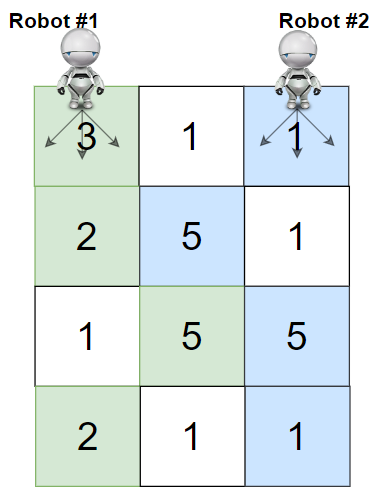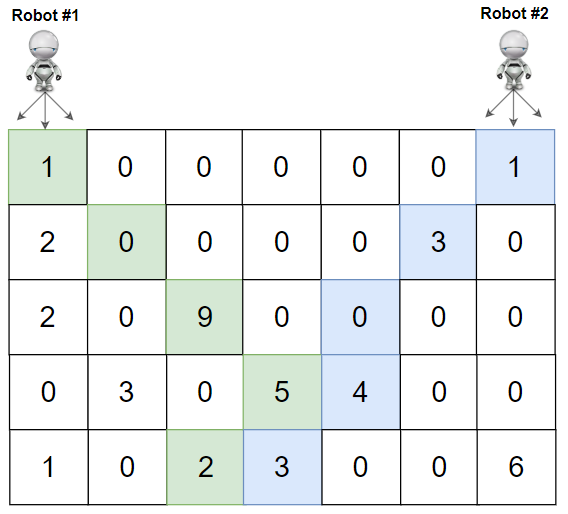You are given a rows x cols matrix grid representing a field of cherries where grid[i][j] represents the number of cherries that you can collect from the (i, j) cell. You have two robots that can collect cherries for you:
Robot #1 is located at the top-left corner (0, 0), and Robot #2 is located at the top-right corner (0, cols - 1).Return the maximum number of cherries collection using both robots by following the rules below:
From a cell (i, j), robots can move to cell (i + 1, j - 1), (i + 1, j), or (i + 1, j + 1).
When any robot passes through a cell, It picks up all cherries, and the cell becomes an empty cell.
When both robots stay in the same cell, only one takes the cherries.
Both robots cannot move outside of the grid at any moment.
Both robots should reach the bottom row in grid.
Example 1:
 Input: grid = [[3,1,1],[2,5,1],[1,5,5],[2,1,1]] Output: 24 Explanation: Path of robot #1 and #2 are described in color green and blue respectively. Cherries taken by Robot #1, (3 + 2 + 5 + 2) = 12. Cherries taken by Robot #2, (1 + 5 + 5 + 1) = 12. Total of cherries: 12 + 12 = 24.
Input: grid = [[3,1,1],[2,5,1],[1,5,5],[2,1,1]] Output: 24 Explanation: Path of robot #1 and #2 are described in color green and blue respectively. Cherries taken by Robot #1, (3 + 2 + 5 + 2) = 12. Cherries taken by Robot #2, (1 + 5 + 5 + 1) = 12. Total of cherries: 12 + 12 = 24.
Example 2:
 Input: grid = [[1,0,0,0,0,0,1],[2,0,0,0,0,3,0],[2,0,9,0,0,0,0],[0,3,0,5,4,0,0],[1,0,2,3,0,0,6]] Output: 28 Explanation: Path of robot #1 and #2 are described in color green and blue respectively. Cherries taken by Robot #1, (1 + 9 + 5 + 2) = 17. Cherries taken by Robot #2, (1 + 3 + 4 + 3) = 11. Total of cherries: 17 + 11 = 28.
Input: grid = [[1,0,0,0,0,0,1],[2,0,0,0,0,3,0],[2,0,9,0,0,0,0],[0,3,0,5,4,0,0],[1,0,2,3,0,0,6]] Output: 28 Explanation: Path of robot #1 and #2 are described in color green and blue respectively. Cherries taken by Robot #1, (1 + 9 + 5 + 2) = 17. Cherries taken by Robot #2, (1 + 3 + 4 + 3) = 11. Total of cherries: 17 + 11 = 28.
Constraints:
rows == grid.length
cols == grid[i].length
2 <= rows, cols <= 70
0 <= grid[i][j] <= 100
- code
class Solution:
def cherryPickup(self, grid: List[List[int]]) -> int:
@lru_cache(maxsize = None)
def dp(row, col1, col2):
if col1 == col2: gain = grid[row][col1]
else: gain = grid[row][col1] + grid[row][col2]
if row == m - 1:
return gain
res = 0
for dcol1, dcol2 in col_directions:
nexcol1, nexcol2 = col1 + dcol1, col2 + dcol2
if 0 <= nexcol1 < n and 0 <= nexcol2 < n:
res = max(res, dp(row + 1, nexcol1, nexcol2))
return gain + res
m = len(grid)
n = len(grid[0])
col_directions = [(1, 1), (1, 0), (1, -1), (0, 1), (0, 0), (0, -1), (-1, 1), (-1, 0), (-1, -1)]
return dp(0, 0, n - 1)
- code
class Solution:
def cherryPickup(self, grid: List[List[int]]) -> int:
m = len(grid)
n = len(grid[0])
dp = [[[0]*n for _ in range(n)] for __ in range(m)]
# for row in reversed(range(m)):
for row in range(m-1, -1, -1):
for col1 in range(n):
for col2 in range(n):
# current cell
result = grid[row][col1]
if col1 != col2:
result += grid[row][col2]
# transition
if row != m-1:
result += max(dp[row+1][new_col1][new_col2]
for new_col1 in [col1, col1+1, col1-1]
for new_col2 in [col2, col2+1, col2-1]
if 0 <= new_col1 < n and 0 <= new_col2 < n)
dp[row][col1][col2] = result
return dp[0][0][n-1]